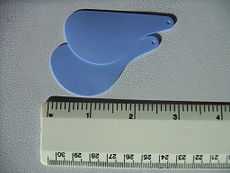Septoplasty
| Septoplasty | |
|---|---|
| Intervention | |
 Typical flexible splints that may be used in septoplasty. They are held in place in the nose with a stitch through the hole, and are typically removed seven to 10 days after surgery. | |
| ICD-9-CM | 21.5, 21.88 |
| MedlinePlus | 003012 |
Septoplasty is a corrective surgical procedure done to straighten the nasal septum, the partition between the two nasal cavities.[1] Ideally, the septum should run down the center of the nose. When it deviates into one of the cavities, it narrows that cavity and impedes airflow. Often the inferior turbinate on the opposite side enlarges, which is termed compensatory hypertrophy. Deviations of the septum can lead to nasal obstruction. Most surgeries are completed in 60 minutes or less, while the recovery time could be up to several weeks. Septoplasty is sometimes done with rhinoplasty for cosmetic correction of the deformities of the external nasal framework.
Procedure
The procedure usually involves a judicious excision/realignment of a portion of the bone and/or cartilage in the nasal cavity. Under general or local anesthesia, the surgeon works through the nostrils, making an incision in the lining of the septum to reach the cartilage targeted in the operation. Sufficient cartilage is preserved for structural support. After the septum is straightened, it may then be stabilized temporarily with small plastic tubes, splints, or sutures internally.
Indications
Apart from in patients with deviated nasal septum, septoplasty is done as an approach to hypophysectomy. It is sometimes done to cure recurrent epistaxis due to septal spur.
Contraindications
Septoplasty should not be done in acute nasal or sinus infection. It should also be avoided if the person has untreated diabetes, severe hypertension or bleeding diathesis.[2]
Post-operation
Unless there are unusual complications, there is no swelling or discoloration to the external nose or face with septoplasty alone. Packing is rare with modern surgical techniques, but splinting the inside of the nose for a few days is common; the splints are not visible externally. One percent of patients can experience excessive bleeding afterwards — the risk period lasts up to two weeks. This could require packing or cautery, but is generally handled safely and without compromise of the ultimate surgical result. Temporary numbness of the front upper teeth after surgery is common. Sometimes the numbness extends to the upper jaw and the tip of the nose. This almost always resolves within several months.
See also
References
- ↑ "Septoplasty". Mediline Plus, U.S National Library of Medicine. Retrieved 29 June 2013.
- ↑ Dhingra, P.L (2010). Diseases of the ear, nose and throat. New Delhi, India: Elsevier Publications. pp. 429–430.
External links
| ||||||||||||||||||||||||||||||||||||||||||||||||||||